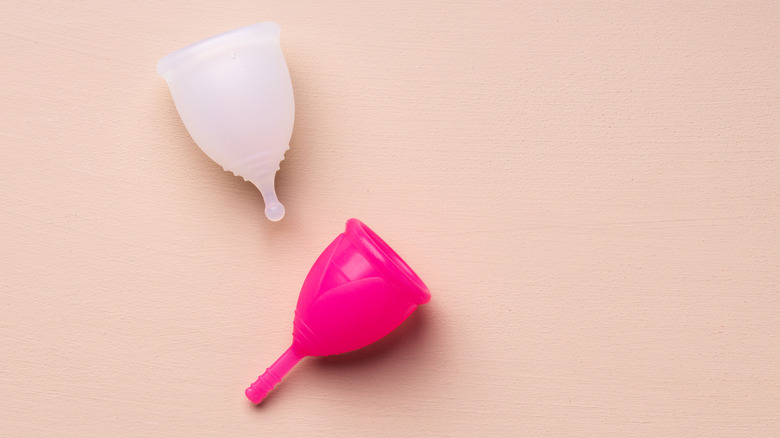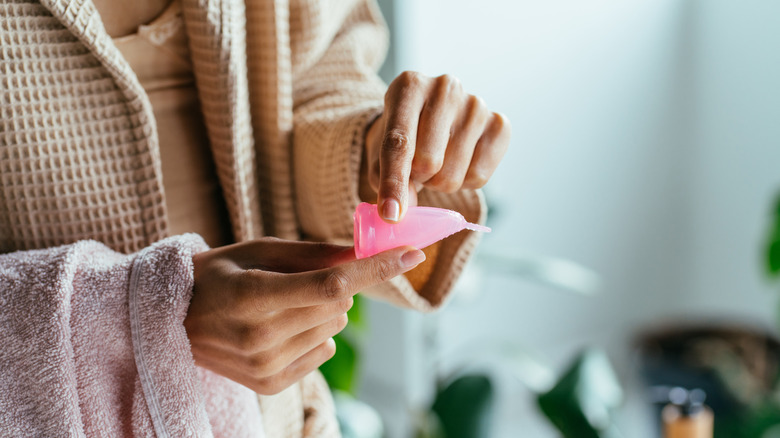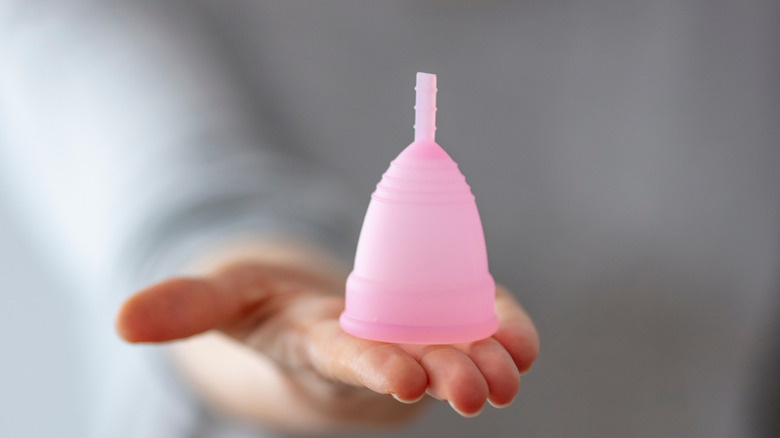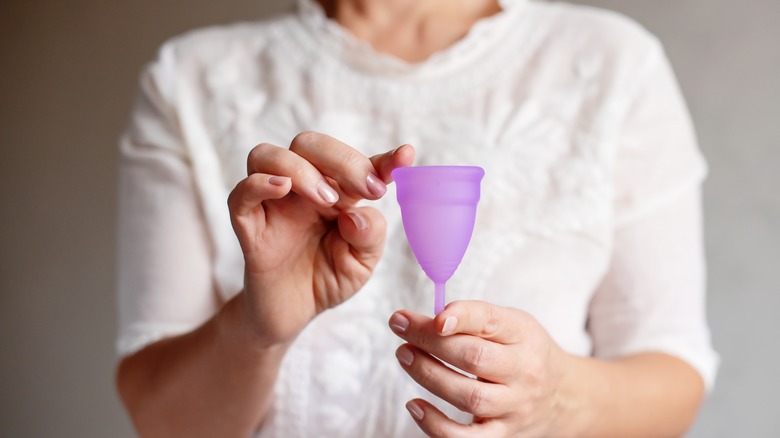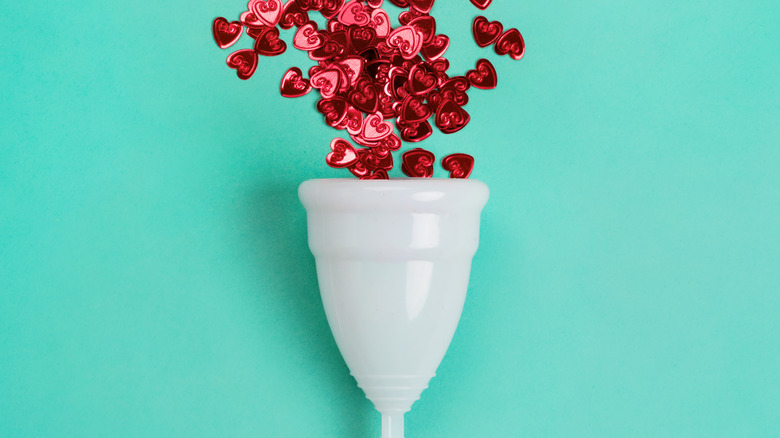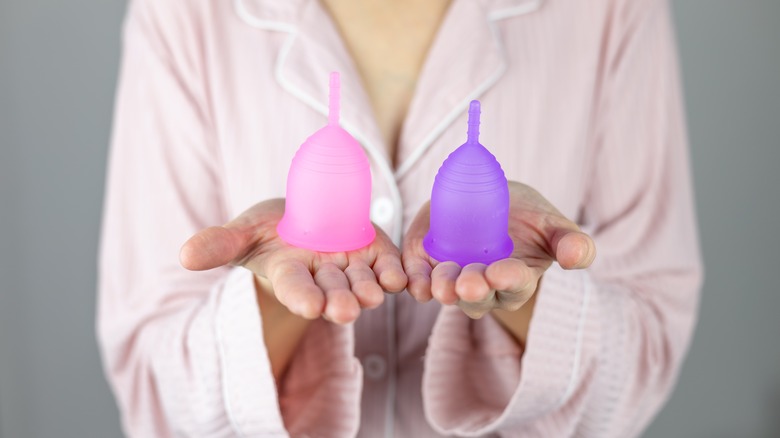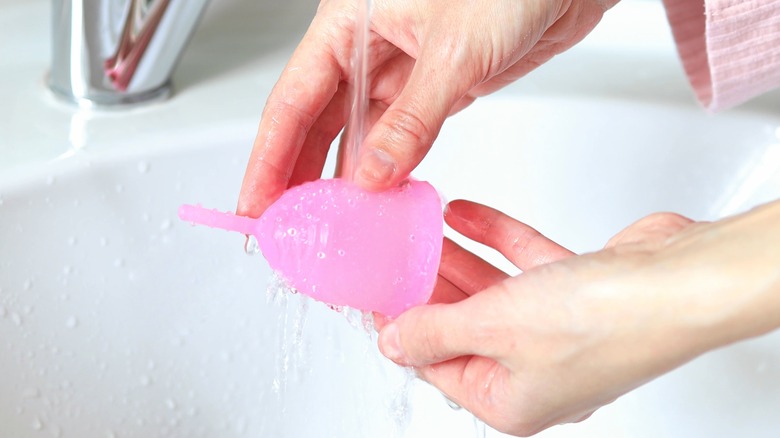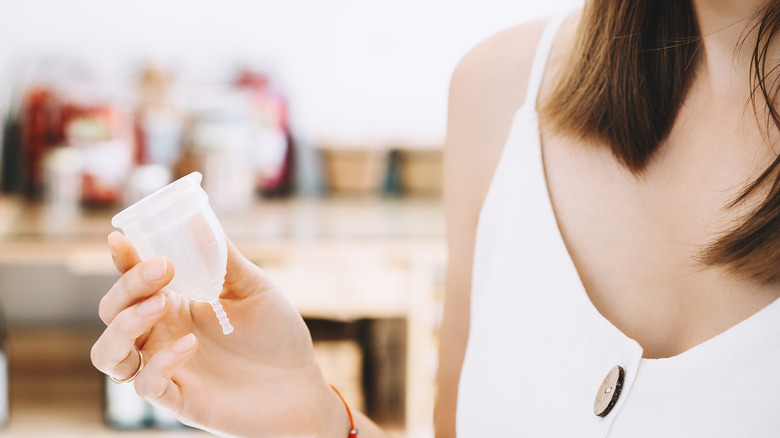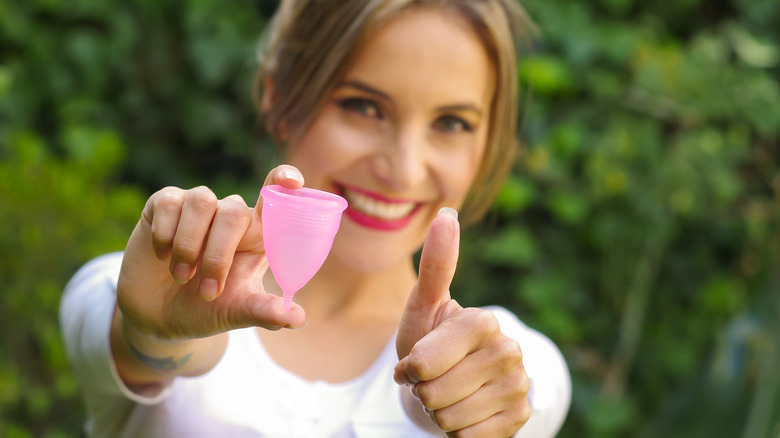Everything You Need To Know Before Switching To A Menstrual Cup
If you've ever dealt with a period and all the problems that come with having one, you'll agree that the last thing you want to worry about when your cycle starts is what type of products you're using. But even deciding that is no walk in the park. You used to simply choose between disposable pads or tampons, but options have ballooned in recent years to include reusable cups, disks, and underwear.
And while most people know that pads and tampons have been around for many years, not many know that menstrual cups have been around for just as long. The first patent for a menstrual cup was awarded back in 1867, per the Cleveland Clinic, and they have been circulating in some form or fashion since then, although not widely.
Made of silicone or rubber, goblet-shaped menstrual cups are designed to be inserted into your vagina to collect blood during your period. It is safe for menstruating people of all ages and sexual experiences to use (via Go Ask Alice!). Before deciding if using a cup is right for you, there are many pros, and a few downsides, you should be aware of.
Insertion and removal
There are a few tricks of the trade when it comes to inserting and removing a menstrual cup. To insert one, first get into a comfortable position, such as sitting on the toilet, squatting, or standing with a leg up (via Mira). Then, fold the cup together. According to JuJu, there are several different folds you can try out so you might want to experiment with a few different methods to find the best one for you. Insert the cup into your vagina then twist it slightly to get it to open up and form a seal, then check for any leakage. According to Mira, wearing panty liners or period underwear along with the cup is a good idea until you get the hang of inserting it.
To remove a cup, you'll need to break its seal. To do so, either push down using your pelvic muscles to push the cup out or squeeze the bottom of the cup together to release its hold (via Mira). Then pull the cup out, making sure to keep it upright, and dump its contents into the toilet.
To get the hang of inserting and removing a cup, you may want to test it out before your period starts. Lubricating it with water-based lube can make that easier.
Pro: Affordability
Compared to pads or tampons, which are disposable, a menstrual cup can save you a lot of money in the bank. Most menstrual cups cost anywhere from $20 to $40, according to Forbes. That might seem steep for one cup, but HuffPost did the math: The average woman has 456 total periods over a span of 38 years. Women who use tampons, specifically, go through about 20 per cycle. A box of 36 tampons costs approximately $7. So, 20 tampons per cycle x 456 periods = 9,120 tampons. At 36 tampons per box, that comes to 253.3 boxes x $7, which equals a whopping $1,773.33 spent on tampons during a woman's lifetime.
While it might seem like a big purchase at first, a reusable menstrual cup is worth the money. According to Heathline, one cup can last up to 10 years when properly taken care of, so its return on investment is great.
Pro: No odor
According to Healthline, it is normal for period blood to have a slight odor after exiting your body, as it is made up of an unfertilized egg, iron, bacteria, and uterine lining tissue. If you practice good hygiene, such as daily showers and changing your period products regularly, it is unlikely that anyone but you will notice any type of odor.
However, if you are self-conscious about the smell of your period, you may want to make the switch to a menstrual cup. Because cups don't expose blood to the air, there is often little to no odor present, according to Cleveland Clinic.
It's important to note that very strong "fishy" smells during your period should be checked out by your healthcare provider (via Healthline). That smell is usually a sign of a medical problem called bacterial vaginosis, which is an infection that is accompanied by burning, itching, and discharge.
Pro: More time between changes
Sometimes you can get so busy that it's hard to even take regular trips to the bathroom. So when extra breaks are needed because you're on your period and have to change a tampon or pad, it can be inconvenient. A menstrual cup can help keep you from running to the bathroom so often.
On average, people who menstruate lose between 30 and 60 milliliters of blood during a cycle, according to Healthline. On average, regular-sized tampons and pads can hold approximately five milliliters of fluid (via Flo). Because of this, it is usually recommended that you change a tampon or pad every four hours to prevent leaks, especially on your heavier days.
A menstrual cup, however, will hold twice that amount or one to two ounces, which is 29-59 milliliters (per Pristyn Care). Many period cup brands advertise that you can go eight to twelve hours before you must empty a cup, which is an average working day. This means that you can put the cup in when you wake up and only empty it when you get home again, in the privacy of your bathroom.
Pro: Eco-friendly
One of the biggest reasons that menstrual cups have come to the forefront now is that they are a very eco-friendly alternative to disposable pads and tampons. Even though they've been around for a long time, most people opted for the convenience of disposables. However, the impact that practice has on the earth is pushing people to make a change.
According to Refinery29, with the number of menstrual products that we use and with the population of the world being what it is, there are currently 20 billion disposables ending up in landfills around the world every year. EVERY. YEAR. In fact, every woman throws out 10,000 to 15,000 tampons, panty liners, or pads in her lifetime (via Reader's Digest).
Sure, there are other eco-friendly options out there for a period, but menstrual cups have them all beat in terms of longevity, convenience, and ease of use. Because most cups are made of silicone or rubber, their materials can be sourced sustainably, according to Better Meets Reality. And menstrual cups can last up to ten years (via Healthline). Cups will certainly continue to grow in popularity as more and more of us consider the impact that our everyday items have on the environment.
Con: Hard to remove
Menstrual cups have their downsides as well. The biggest complaint is that they are hard to remove — at least for beginners. Because everyone's body is different, there is no wrong or right way to do it and that's why it's so tricky. You have to come up with the best way for yourself.
According to Almost Zero Waste, there are some tips that may help, including squatting or putting one leg up, using your pelvic muscles to bear down, and, probably the most crucial ... relaxing.
While these tips are all well and good when you're in a private space, the experience can be different when you're in a public bathroom. You might not be as comfortable squatting right on the seat or the space might not be big enough for you to maneuver properly. Many users of menstrual cups also warn about the suction noise that the cup can make when its seal is broken. Again, if you're in a public restroom this might make it highly uncomfortable if there are any other people in there with you.
Con: More mess
While it does seem that wearing a cup will create less mess, it can take some getting used to before you get to that point. It's recommended to only wear your cup for half the maximum time allowed at the beginning so that you have less of a chance to spill when removing it (via Almost Zero Waste).
The potential mess you can create when removing a cup is also why some suggest removing it in the shower so as to not have to worry about making sure everything goes in the toilet. Otherwise, you might have some cleanup to do and may even have some ruined items as you could spill on your clothing or rugs on the floor.
According to Almost Zero Waste, you will likely also get blood on your fingers as you remove the cup, and you will have to wash it before re-inserting it. If any of that puts you off, a menstrual cup may not be the right choice for you.
Con: Fit problems
In recent years, the menstrual cup market has boomed, and the global market for them is expected to hit $1.89 billion by 2026, according to Cleveland Clinic. As a result, there are multiple styles and sizes available. While that might seem great, at a $20 average cost per cup, it can become pretty expensive to try out a handful of them before you find one that fits you just right.
Usually, cups come in two sizes, according to Healthline. The smaller size is for those that are under 30 years old or haven't had a vaginal birth yet. And the larger size is for those who are older or that have delivered children naturally. Unfortunately, this formula may not work for everyone, as you can be younger but have a larger vaginal canal and need the larger size anyway. Or you might have had a few kids but have a narrow canal and thus need the smaller size.
While most cups are similarly shaped, they can vary widely in details and even the material they're made from (via Women's Health). Some are firmer while others are more malleable. Some are better for those that have narrow vaginal canals and some are better suited for people with higher cervixes.
Con: Regular sterilization
Although menstrual cups can save you from Toxic Shock Syndrome, a complication associated with using tampons, according to Go Ask Alice!, you still have to be pretty careful when using them. As opposed to pads that do not get inserted inside your body, menstrual cups sit inside of your body for quite a while during a cycle and have plenty of time to harbor bacteria.
This can be avoided by washing your cup with warm water and soap between uses, after emptying the contents in the toilet (via Blood & Milk). It sounds pretty easy to do when you're in the privacy of your own bathroom, but a public bathroom poses its own challenges. Once you have cleaned your cup though, you must take extra care to ensure there's no soap left behind that will irritate your vaginal canal, or use a pH-balanced soap from the beginning.
Once your cycle is complete for the month, a menstrual cup must also be sterilized to prevent it from being a breeding ground for bacteria while it is in storage. It must be boiled in water for a certain amount of time or sterilized in the same manner that you would sterilize baby bottle nipples. This can be an annoying step for some and even be forgotten, which can lead to complications once you go to use the cup again.
Best cup overall
With a price point of $29 and three different colors to choose from, the Saalt Menstrual Cup wins awards all around the board. It was designed by experts from Put a Cup In It, an informative website for those searching for their perfect cup or deciding if using a cup is even for them.
Its super soft silicone material makes it easy to insert and remove, and the bulb shape is easily foldable in multiple ways. It's perfect for beginners and those that have a more sensitive pelvic floor and is also great for those that experience frequent or intense cramps during their periods. The soft rounded edges seal well so that you're protected from leaks. The cup also comes in two different sizes, small and regular, so that you can pick which is best for your body.
With more than 12,000 reviews on Amazon, we can see why the Saalt cup is a favorite. Reviewers mentioned that the cup stays in place even when going to the bathroom, is easily wearable all day, and is more comfortable than other brands they tried.
Most affordable cup
We recommend the budget-friendly Honey Pot menstrual cup if you're on a tight budget. It comes in at $20 and has two different sizes to choose from. The Honey Pot Company boasts that it has one of the few cups on the market that uses silicone free from latex and is approved by gynecologists to wear overnight.
Reviewers couldn't stop raving about the Honey Pot, with many saying they finally jumped on the menstrual cup bandwagon after years of being apprehensive. One reviewer said: "I have PCOS & have extremely heavy periods! Since I started using this product I can't even tell I'm on my period! I absolutely love it! My flow doesn't even get in the way anymore."
According to most others, it also delivered on its 12-hour promise and overnight protection with very few or no leaks at all. Another reviewer even commented that it was easy to insert and remove, even with long, fake nails!
Best cup for beginners
The Intimina Lily Cup looks a bit different than most menstrual cups on the market but that uniqueness seems to be what makes it just perfect for beginner users of menstrual cups. The cup has more of a slant than others on the market and has an eight-hour capacity, although it could be left in up to 12 hours during light flow days. The Intimina also has two sizes, A and B, and the same brand also makes a cup specifically for teens.
The other unique feature of this cup is that it has a lip at the top which makes it easier to contain fluid during the removal process — something that many menstrual cup users struggle with, especially at the beginning. At just $23, it is also relatively affordable as compared to a few other cups.
Reviewers were happy with the amount of control they had during insertion and removal while using the Intimina cup and the fact that it can be used by those with higher cervixes as well. It was also praised for being super soft and that the lip helped to keep spills from happening.
